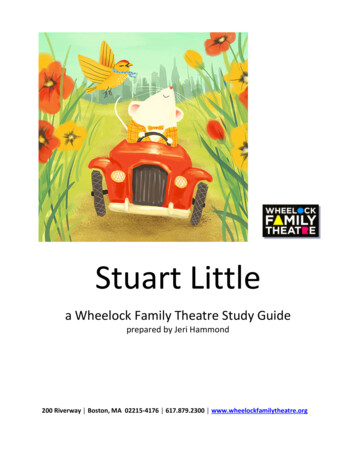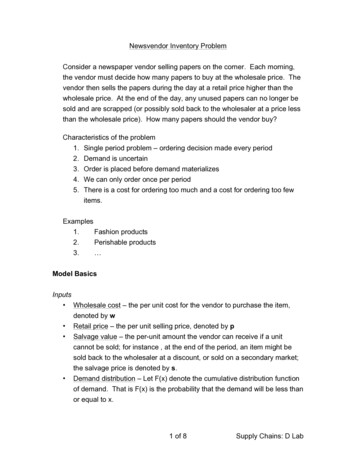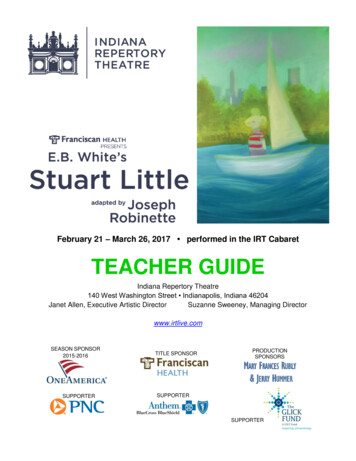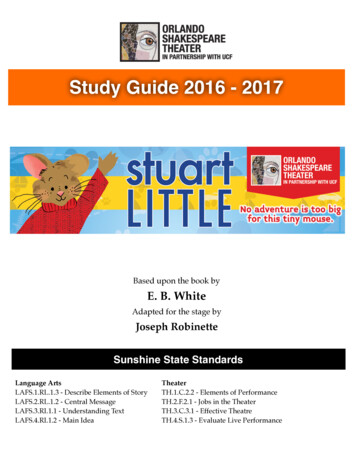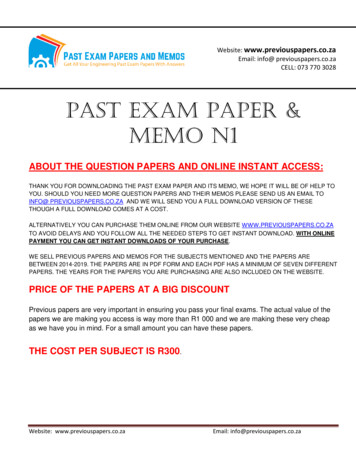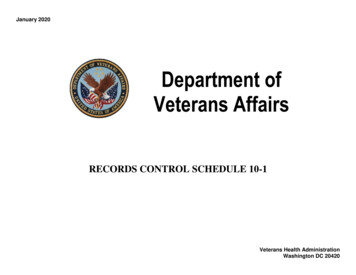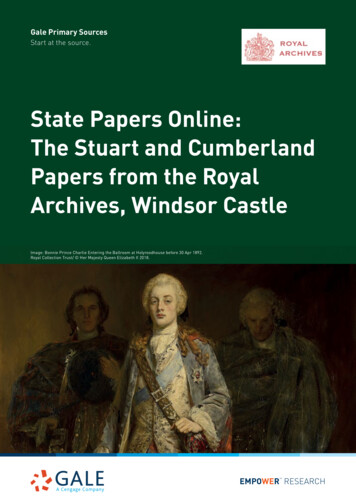
Transcription
Gale Primary SourcesStart at the source.State Papers Online:The Stuart and CumberlandPapers from the RoyalArchives, Windsor CastleImage: Bonnie Prince Charlie Entering the Ballroom at Holyroodhouse before 30 Apr 1892.Royal Collection Trust/ Her Majesty Queen Elizabeth II 2018.EMPOWER RESEARCH
STATE PAPERS ONLINE: THE STUART AND CUMBERLANDPAPERS FROM THE ROYAL ARCHIVES, WINDSOR CASTLEThis archive contains two remarkable collections which have been digitised by Gale, in partnershipwith the Royal Archives, Windsor Castle, as part of the State Papers Online programme.NUMBER OFMANUSCRIPTIMAGES:Stuart papers170,000Cumberland papers75,000Total245,000THE STUART AND CUMBERLAND PAPERS –A BRIEF HISTORYThe Stuart Papers were acquired by George IVwhen Prince Regent, following the death of HenryBenedict Stuart, Cardinal York, and were originallykept in the Prince’s Library at Carlton House.Comprising 541 bound volumes of the ‘Main’documents, plus 89 ‘Miscellaneous’ volumes, 9sets of ‘Additional’ papers, and 925 seals, TheStuart Papers are an invaluable collection detailingthe fortunes of the last Stuarts after the exile ofJames II and VII in 1688. The majority of thesepapers concern the period 1713 to 1770, and providean insight into Jacobite attempts to regain thethrone, while later papers concern Cardinal York’srelations with the Vatican until his death in 1807.Deposited in the Royal Archives at its foundation,The Cumberland Papers are the military papersof William Augustus, Duke of Cumberland,dating from 1649-1765, alongside his militarycorrespondence and order books from thecampaigns of the War of the Austrian Succession,the 1745 Jacobite Uprising and the Seven Years’War. They also contain household accounts fromCumberland Lodge and records of the Duke’stenure as Ranger of the Great Park at Windsor,until his death in 1765.RA CP/Main/7/117: Instructions from George II to the Duke of Cumberland, 25 November 1745.Supplied by the Royal Archives / Her Majesty Queen Elizabeth II 2018.For more information visit gale.com/scp
WHY IS THIS ARCHIVE IMPORTANT?Scholars and students will have online access to The Stuart Papers and The Cumberland Papers for thefirst time. Covering the span of the Jacobite movement from the Glorious Revolution in 1688 to the deathof the last Stuart heir, Henry Benedict, Cardinal Duke of York in 1807, The Stuart Papers provide intimateinsights into the social, military and personal worlds of the Jacobite claimants and their followers. Withthe private and diplomatic correspondence of James II and VII, James III and VIII and Bonnie Prince Charliealongside those of the nobles, exiles, soldiers and spies who made up the European Jacobite network,the collection includes detailed coverage of the failed rebellions of 1715 and 1745, the internationalcorrespondence and plots of the Jacobites, and the daily workings of the Stuart government-in-exile.Digitising these papers alongside those of the Duke of Cumberland, the second surviving son of George IIand a key figure in the Hanoverian monarchy, allows direct perspectives simultaneously into both Jacobiteplots and uprisings, and the methods used to suppress them.The inclusion of searchable metadata for the documents, created from the HMC Calendars to the StuartPapers, as well as writer and addressee index cards from the Royal Archives, allows researchers streamlined and incisive access to thousands of documents. Differing perspectives on key domestic and international events facilitates research into bothJacobite and Hanoverian policy The wide range of documents enables scholars to explore a broad range of topics and themes Cross-searchability between the two collections allows the researcher to contextualise eventsand discover hidden connections Ease of discovery of over-looked or previously little studied aspects of Jacobitism in theeighteenth century“The digitisation of The Stuart andCumberland Papers is one of themost important projects I’ve everbeen involved with. By digitisingthose two collections, we’re goingto make accessible the undergroundarchive of revolutionary movementin the 18th Century and the meansused to suppress that movementsimultaneously.”Daniel SzechiACADEMIC ADVISOR: DANIEL SZECHIEmeritus Professor of Early Modern History,University of Manchester, UKDaniel Szechi has been exploring andresearching the Jacobite mind for over 30years and is eminently recognisable as anexpert in his field. As well as being a prolificauthor and lecturer, Daniel is also a Chair ofthe Jacobite Studies Trust.Scholarly essays have been written byProfessors John Miller, Edward Corp,Murray Pittock, Daniel MacCannell,Paul Monod and Drs Nathalie Genet-Rouffiac,Éamonn Ó Ciardha, Anita Gillespie,Jonathan Oates as well as Laura Hobbs,Archivist at the Royal Archives.gale.com/scp
VALUABLE HISTORICAL DOCUMENTSThe treasure trove of material in The Stuart and Cumberland Papers providesimmeasurable benefits to scholarship. Examples of the content and rangeof the historical documents include: James II and VII and Mary of Modena’s letter books from 1688 Plans and correspondence surrounding the Jacobite Rebellion of 1715 Discussion over the hunt for a wife for James Edward around thecourts of Europe, and subsequent letters about the Polish PrincessClementina Sobieska Details around a failed Jacobite plot with Spain in 1719 Letters surrounding the Atterbury plot 1721-1723 Details of the battles of Falkirk Muir, Prestonpans and Culloden, andthe ‘pacification’ of the Scottish Highlands after the Rebellion of 1745 Henry Benedict Stuart’s decision to accept a cardinalate in June 1747 Accounts of Charles Edward’s arrest at the Paris Opera in 1748,including his own Details of the British army under the Duke of Cumberland in the War ofthe Austrian Succession British colonial ambitions and movements in India and the Americas asseen in the Cumberland Papers Quarrels and religious tension between the Protestant and Catholicfactions of the Stuart court-in-exileRELEVANT TO RESEARCHERS IN Early Modern British and European History Eighteenth Century History and Politics Jacobite Studies Military History Scottish and Irish Studies Court StudiesFrom top:Princess Clementina Sobieska (1702-1735) 1845.Royal Collection Trust/ Her Majesty Queen Elizabeth II 2018.RA CP/Main/69/408: Journal of the Young Pretender, before, at, and after the Battle of Culloden,1746. Copied from a Manuscript, January 1748.Supplied by the Royal Archives / Her Majesty Queen Elizabeth II 2018.RA SP/Main/40/126a: Barracks & Redouts to be erected by the Government in the Highlands ofScotland, 1718. Supplied by the Royal Archives / Her Majesty Queen Elizabeth II 2018.RA CP/Main/5/164: Plan of Prestonpans, 21 September 1745.Supplied by the Royal Archives / Her Majesty Queen Elizabeth II 2018.For more information visit gale.com/scp
WHO’S WHOJAMES II AND VII (1633–1701/ REIGNED 1685–1688)Son of Charles I and brother to Charles II, James’ Catholic faith led to theExclusion Crisis of 1679-81, and ultimately to the Glorious Revolution of1688. His escape to France in that year was deemed a de facto abdicationand his throne taken by his daughter, who ruled as Mary II with herhusband, William of Orange (William III). James thereafter lived atSt Germain-en-Laye, near Versailles, given to him during his exile byhis cousin, Louis XIV of France.JAMES FRANCIS EDWARD STUART “THE OLD PRETENDER” (1688–1766)The son of James II and VII and Mary of Modena, his birth as a Catholicheir to the thrones of England, Ireland and Scotland was a key factor inthe Glorious Revolution. Raised in St Germain-en-Laye, he became theJacobite James III and VIII on his father’s death in 1701 and outlived fivereigning monarchs of the British Throne, Mary II, William of Orange, Anne,George I and George II.CHARLES EDWARD STUART “THE YOUNG PRETENDER” (1720–1788)Best known later as the Bonnie Prince Charlie of the Jacobite Uprising of1745, the eldest son of James Francis Edward and Clementina Sobieska,Charles was granted powers of regency to the Jacobite throne by hisfather in 1743 and led the Jacobite Rising of 1745.HENRY BENEDICT STUART, CARDINAL DUKE OF YORK (1725–1807)Younger brother of Charles Edward Stuart and the final Jacobite claimantto the throne, Henry Benedict outraged his brother by becoming aCardinal in 1747, and spent most of his life in Rome.WILLIAM AUGUSTUS, DUKE OF CUMBERLAND (1721–1765)Second surviving son of George II, and George III’s uncle, the Dukeof Cumberland was an important figure in Georgian Britain, first asa military commander and later as an adviser to his nephew. He ledcampaigns on the Continent and in Britain itself, and was involved inBritain’s colonial policy and wars in the Americas and India.Images (right, from top):James II & VII (1633-1701)when Duke of York c. 1665James Francis Edward Stuart,The Old Pretender (1688-1765)Signed and dated 1848Henry Benedict Stuart (17251807), Cardinal York c.1760William Augustus, Duke ofCumberland (1721-1765) c.1750All: Royal Collection Trust/ Her Majesty QueenElizabeth II 2018.Left:RA SP/Box/3/1/58: “Genealogiede la Maison Royalle de laGrande Bretagne”. Suppliedby the Royal Archives / HerMajesty Queen Elizabeth II 2018.gale.com/scp
USING STATE PAPERS ONLINEThe Stuart and Cumberland Papers is cross-searchable with the original State Papers Online series,harnessing all the same search technology to deepen the research process.On State Papers Online the original historical manuscripts are linked to fully searchable Calendarentries or other metadata, offering access to these documents via search in addition to browse bymanuscript series, or volume.Users can carry out basic and advanced searches with limiters, view illustrations and maps,magnify or rotate images, make notes on a document in an integrated notepad and view twomanuscripts or calendar entries side-by-side to draw comparisons.Research tools include essays by leading scholars with links to the documents mentioned, keydocuments, chronologies, an image gallery of contextual images, related links and references.For more information visit gale.com/scp
If The Stuart and Cumberland Papers from the Royal Archives, Windsor Castle is avaluable resource to you, you will be interested in other Gale archives, especially:State Papers Online, 1509-1714, published in four parts, is a digitisation of the British “State Papers” (SP) seriesfrom the National Archives, Kew, and offers researchers a ground-breaking online resource for understandingtwo hundred years of British and European history, from the reign of Henry VIII to the end of the reign ofQueen Anne. The correspondence, reports, memoranda, and parliamentary drafts from ambassadors, civilservants and provincial administrators present a full picture of Tudor and Stuart Britain.State Papers Online: Eighteenth Century, 1714-1782 represents the final section of the State Papers series fromthe National Archives in the UK before the series was closed and replaced by the Home Office and Foreign Officeseries in 1782. Covering the reigns of the Hanover rulers George I (1714-1727) and George II (1727-1760) and partof the reign of George III (up to 1782), the series provides unparalleled access to thousands of manuscripts thatreveal the behind-the-scenes, day-to-day running of the British Government during the eighteenth century. Thearchive is vital to any understanding of the political, social, and economic history of the period and an essentialresource for any scholar or student studying Britain and Europe in the eighteenth century.Eighteenth Century Collections Online (ECCO) contains every significant English language and foreign-languagetitle printed in the United Kingdom between the years 1701 and 1800. ECCO Part I and Part II include more than32 million pages of text. While many works in ECCO are in the English language, researchers will also discovera rich vein of works printed in Dutch, French, German, Italian, Latin, Spanish, and Welsh.17th and 18th Century Burney Newspapers Collection and the 17th and 18th Century Nichols NewspapersCollection complement each other, in an unparalleled digital reference resource. These archives representthe largest single collection of English news media from these two centuries, including titles from England,Scotland, Ireland, and several British colonies.To learn more information about these archives please visit gale.com/primary-sources
Image: Bonnie Prince Charlie Entering the Ballroom at Holyroodhouse before 30 Apr 1892.Royal Collection Trust/ Her Majesty Queen Elizabeth II 2018.@GaleEMEA9780418286852For a free trial, pricing, or further information,find your local representative at gale.com/repor email emea.enquiries@cengage.com
USING STATE PAPERS ONLINE The Stuart and Cumberland Papers is cross-searchable with the original State Papers Online series, harnessing all the same search technology to deepen the research process. On State Papers Online the original historical manuscripts are linked to fully searchable Calendar entries or other


